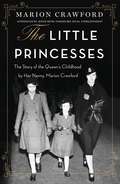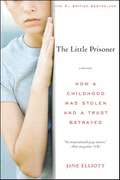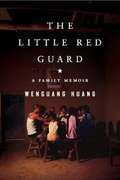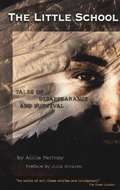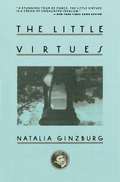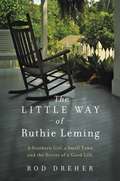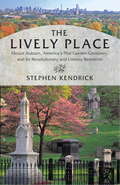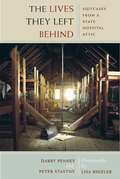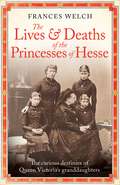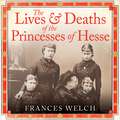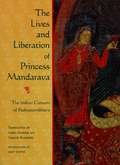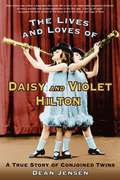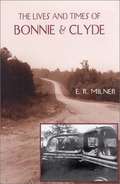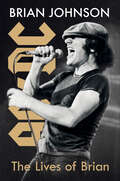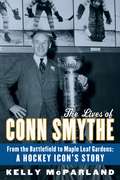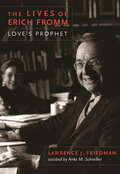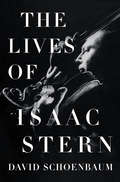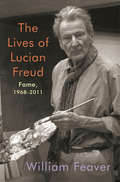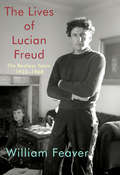- Table View
- List View
The Little Princesses: The extraordinary story of the Queen's childhood by her Nanny. Perfect for readers of The Lady in Waiting
by Marion Crawford'A unique insight into the isolated childhood of the future queen and her sister' YOU MAGAZINE, THE DAILY MAIL~The touching and ground-breaking stories of the Queen and Princess Margaret's childhoods told by their nanny, Marion Crawford. With a foreword by former BBC Royal Correspondent Jennie Bond, Marion reveals the royal family's life before The Crown.Now, more than ever, the Royal Family's private lives are the stuff of soap opera and it seems anyone who comes into contact with them sells their story to the magazines or to the newspapers. Marion Crawford, 'Crawfie', as she was known to the Queen and Princess Margaret, became governess to the children of the Duke and Duchess of York in the early 1930s, little suspecting she was nurturing her future Queen. Beginning at the quiet family home in Piccadilly and ending with the birth of Prince Charles at Buckingham Palace in 1948, Crawfie tells how she brought the princesses up to be 'Royal' whilst also exposing them to the ordinary world of underground trains, buses and swimming lessons. THE LITTLE PRINCESSES was published in 1950 to a furore we cannot imagine today. Crawfie was demonised by the press, and the Queen Mother - who had been a great friend and who had, Crawfie maintained, given her permission to write the account - never spoke to her again.
The Little Princesses: The extraordinary story of the Queen’s childhood by her Nanny. Perfect for readers of The Lady in Waiting
by Marion Crawford'A unique insight into the isolated childhood of the future queen and her sister' YOU MAGAZINE, THE DAILY MAIL~The touching and ground-breaking stories of the Queen and Princess Margaret's childhoods told by their nanny, Marion Crawford. With a foreword by former BBC Royal Correspondent Jennie Bond, Marion reveals the royal family's life before The Crown.Now, more than ever, the Royal Family's private lives are the stuff of soap opera and it seems anyone who comes into contact with them sells their story to the magazines or to the newspapers. Marion Crawford, 'Crawfie', as she was known to the Queen and Princess Margaret, became governess to the children of the Duke and Duchess of York in the early 1930s, little suspecting she was nurturing her future Queen. Beginning at the quiet family home in Piccadilly and ending with the birth of Prince Charles at Buckingham Palace in 1948, Crawfie tells how she brought the princesses up to be 'Royal' whilst also exposing them to the ordinary world of underground trains, buses and swimming lessons. THE LITTLE PRINCESSES was published in 1950 to a furore we cannot imagine today. Crawfie was demonised by the press, and the Queen Mother - who had been a great friend and who had, Crawfie maintained, given her permission to write the account - never spoke to her again.
The Little Prisoner: A Memoir
by Jane ElliottWhen Jane Elliott was four years old, the nightmare began. She became the helpless victim of a sociopath—bullied, dominated, and sexually abused by a man only fourteen years her senior: her stepfather. For nearly two decades she was held prisoner, both physically and emotionally. But at the age of twenty-one she escaped . . . and then she fought back.The Little Prisoner is the shocking, astonishing, and ultimately uplifting true story of one woman's shattering twenty-year ordeal—and how she triumphed against an evil and violent human monster when honesty and bravery were her only weapons.
The Little Red Guard: A Family Memoir
by Wenguang HuangA Washington Post Best of 2012 pickThree generations of a family living under one roof reflect the dramatic transformations of an entire society in this memoir of life in 20th century ChinaWhen Wenguang Huang was nine years old, his grandmother became obsessed with her own death. Fearing cremation, she extracted from her family the promise to bury her after she died. This was in Xi’an, a city in central China, in the 1970s, when a national ban on all traditional Chinese practices, including burials, was strictly enforced. But Huang’s grandmother was persistent, and two years later, his father built her a coffin. He also appointed his older son, Wenguang, as coffin keeper, a distinction that meant, among other things, sleeping next to the coffin at night.Over the next fifteen years, the whole family was consumed with planning Grandma’s burial, a regular source of friction and contention, with the constant risk of being caught by the authorities. Many years after her death, the family’s memories of her coffin still loom large. Huang, now living and working in America, has come to realize how much the concern over the coffin has affected his upbringing and shaped the lives of everyone in the family. Lyrical and poignant, funny and heartrending, The Little Red Guard is the powerful tale of an ordinary family finding their way through turbulence and transition.
The Little School
by Julia Alvarez Alicia PartnoyOne of Argentina's 30,000 "disappeared," Alicia Partnoy was abducted from her home by secret police and taken to a concentration camp where she was tortured, and where most of the other prisoners were killed. Her writings were smuggled out of prison and published anonymously in human rights journals. The Little School is Alicia Partnoy's memoir of her disappearance and imprisonment in Argentina in the 1970s. Told in a series of tales that resound in memory like parables, The Little School is proof of the resilience of the human spirit and the healing powers of art.This second edition features a revised introduction by the author and a preface by Julia Alvarez.
The Little School: Tales of Disappearance and Survival
by Alicia PartnoyOne of Argentina's 30,000 "disappeared," Alicia Partnoy was abducted from her home by secret police and taken to a concentration camp where she was tortured, and where most of the other prisoners were killed. Her writings were smuggled out of prison and published anonymously in human rights journals. The Little School is Alicia Partnoy's memoir of her disappearance and imprisonment in Argentina in the 1970s. Told in a series of tales that resound in memory like parables, The Little School is proof of the resilience of the human spirit and the healing powers of art. This second edition features a revised introduction by the author and a preface by Julia Alvarez.
The Little Virtues: Essays
by Natalia Ginzburg“As far as the education of children is concerned,” states Natalia Ginzburg in this collection of her finest and best-known short essays, “I think they should be taught not the little virtues but the great ones. Not thrift but generosity and an indifference to money; not caution but courage and a contempt for danger; not shrewdness but frankness and a love of truth; not tact but a love of one’s neighbor and self-denial; not a desire for success but a desire to be and to know.” Whether she writes of the loss of a friend, Cesare Pavese; or what is inexpugnable of World War II; or the Abruzzi, where she and her first husband lived in forced residence under Fascist rule; or the importance of silence in our society; or her vocation as a writer; or even a pair of worn-out shoes, Ginzburg brings to her reflections the wisdom of a survivor and the spare, wry, and poetically resonant style her readers have come to recognize. “A glowing light of modern Italian literature . . . Ginzburg’s magic is the utter simplicity of her prose, suddenly illuminated by one word that makes a lightning streak of a plain phrase. . . . As direct and clean as if it were carved in stone, it yet speaks thoughts of the heart.” —The New York Times Book Review
The Little Way of Ruthie Leming: A Southern Girl, a Small Town, and the Secret of a Good Life
by Rod DreherTHE LITTLE WAY OF RUTHIE LEMING follows Rod Dreher, a Philadelphia journalist, back to his hometown of St. Francisville, Louisiana (pop. 1,700) in the wake of his younger sister Ruthie's death. When she was diagnosed at age 40 with a virulent form of cancer in 2010, Dreher was moved by the way the community he had left behind rallied around his dying sister, a schoolteacher. He was also struck by the grace and courage with which his sister dealt with the disease that eventually took her life. In Louisiana for Ruthie's funeral in the fall of 2011, Dreher began to wonder whether the ordinary life Ruthie led in their country town was in fact a path of hidden grandeur, even spiritual greatness, concealed within the modest life of a mother and teacher. In order to explore this revelation, Dreher and his wife decided to leave Philadelphia, move home to help with family responsibilities and have their three children grow up amidst the rituals that had defined his family for five generations-Mardi Gras, L.S.U. football games, and deer hunting. As David Brooks poignantly described Dreher's journey homeward in a recent New York Times column, Dreher and his wife Julie "decided to accept the limitations of small-town life in exchange for the privilege of being part of a community."
The Lively Place
by Stephen KendrickThe story of one of the Boston area's most famous attractions, the Mount Auburn Cemetery, and how its founders and "residents" have influenced American culture When the Mount Auburn Cemetery was founded, in 1831, it revolutionized the way Americans mourned the dead by offering a peaceful space for contemplation. This cemetery, located not far from Harvard University, was also a place that reflected and instilled an imperative to preserve and protect nature in a rapidly industrializing culture--lessons that would influence the creation of Central Park, the cemetery at Gettysburg, and the National Parks system. Even today this urban wildlife habitat and nationally recognized hotspot for migratory songbirds continues to connect visitors with nature and serves as a model for sustainable landscape practices. Beyond Mount Auburn's prescient focus on conservation, it also reflects the impact of Transcendentalism and the progressive spirit in American life seen in advances in science, art, and religion and in social reform movements. In The Lively Place, Stephen Kendrick celebrates this vital piece of our nation's history, as he tells the story of Mount Auburn's founding, its legacy, and the many influential Americans interred there, from religious leaders to abolitionists, poets, and reformers.
The Lives They Left Behind
by Robert Whitaker Darby Penney Peter Stastny Lisa Rinzler"The Lives They Left Behind is a deeply moving testament to the human side of mental illness, and of the narrow margin which so often separates the sane from the mad. It is a remarkable portrait, too, of the life of a psychiatric asylum--the sort of community in which, for better and for worse, hundreds of thousands of people lived out their lives. Darby Penney and Peter Stastny's careful historical (almost archaeological) and biographical reconstructions give us unique insight into these lives which would otherwise be lost and, indeed, unimaginable to the rest of us."--Oliver Sacks, M.D., Professor of Neurology and Psychiatry, Columbia University Medical Center, Columbia University Artist, and author of Musicophilia "The haunting thing about the suitcase owners is that it's so easy to identify with them."--Newsweek "In their poignant detail the items helped rescue these individuals from the dark sprawl of anonymity."--The New York Times "[The authors] spent 10 years piecing together . . . the lives these patients lived before they were nightmarishly stripped of their identities."--Newsday More than four hundred abandoned suitcases filled with patients' belongings were found when Willard Psychiatric Center closed in 1995 after 125 years of operation. They are skillfully examined here and compared to the written record to create a moving--and devastating--group portrait of twentieth-century American psychiatric care.
The Lives They Left Behind: Suitcases from a State Hospital Attic
by Darby Penney Peter StastnyThis book grew out of ten years of research conducted by two journalists who discovered a trove of abandoned trunks and suitcases in an attic at Willard State Hospital in New York. Through extensive research they were able to reconstruct the histories of ten patients who were hospitalized at Willard during the years before deinstitutionalization. Through the microcosm of individual lives the authors humanize the tragedy of our treatment of people deemed to be mentally ill.
The Lives and Deaths of the Princesses of Hesse: The curious destinies of Queen Victoria's granddaughters
by Frances WelchA gripping family saga and a portrait of a world in turmoilThe Princesses of Hesse were Queen Victoria's grandchildren. After the sudden death of her daughter Alice, Queen Victoria took an obsessive interest in the marriage prospects of the four girls she left behind. Very little went according to plan. Fortunately, Queen Victoria did not live to see her direst fears for the girls spouses being realised. She died in January 1901, just before her beloved Hesse granddaughters became caught up in the maelstrom of early 20th century Europe. The youngest sister, Alix, married Tsar Nicholas II of Russia; she was assassinated, along with the rest of her family, in a cellar in Ekaterinburg. The second, Ella, married the Russian Grand Duke Serge. After he was assassinated, she became a nun, only to be assassinated by the Bolsheviks twenty-four hours after Alix in 1918. The third, Irene, married the Kaiser's brother, Prince Henry, and was entangled in the 1918 German uprisings. The eldest sister, Princess Victoria, married Prince Louis Battenberg, and became the mother of Lord Louis Mountbatten and grandmother of Prince Philip, Duke of Edinburgh.Their lives were all dramatic, and this group biography shows how they interacted as sisters, forever jostling for status and relaying the politics and intrigues that surrounded them. Drawing on hundreds of previously unseen letters from the sisters as well as from their grandmother Queen Victoria, The Princesses of Hesse takes us on a sweeping journey across the tumultuous landscape of the turn of the century - from the dramas of the Russian Court to the Russian Revolution, and through both World Wars in which they often found themselves on opposing sides.Both intimate and epic in scope, Frances Welch's biography sheds new light on the four sisters' lives, illuminating a remarkable period of history in the process.
The Lives and Deaths of the Princesses of Hesse: The curious destinies of Queen Victoria's granddaughters
by Frances WelchA gripping family saga and a portrait of a world in turmoilThe Princesses of Hesse were Queen Victoria's grandchildren. After the sudden death of her daughter Alice, Queen Victoria took an obsessive interest in the marriage prospects of the four girls she left behind. Very little went according to plan. Fortunately, Queen Victoria did not live to see her direst fears for the girls spouses being realised. She died in January 1901, just before her beloved Hesse granddaughters became caught up in the maelstrom of early 20th century Europe. The youngest sister, Alix, married Tsar Nicholas II of Russia; she was assassinated, along with the rest of her family, in a cellar in Ekaterinburg. The second, Ella, married the Russian Grand Duke Serge. After he was assassinated, she became a nun, only to be assassinated by the Bolsheviks twenty-four hours after Alix in 1918. The third, Irene, married the Kaiser's brother, Prince Henry, and was entangled in the 1918 German uprisings. The eldest sister, Princess Victoria, married Prince Louis Battenberg, and became the mother of Lord Louis Mountbatten and grandmother of Prince Philip, Duke of Edinburgh.Their lives were all dramatic, and this group biography shows how they interacted as sisters, forever jostling for status and relaying the politics and intrigues that surrounded them. Drawing on hundreds of previously unseen letters from the sisters as well as from their grandmother Queen Victoria, The Princesses of Hesse takes us on a sweeping journey across the tumultuous landscape of the turn of the century - from the dramas of the Russian Court to the Russian Revolution, and through both World Wars in which they often found themselves on opposing sides.Both intimate and epic in scope, Frances Welch's biography sheds new light on the four sisters' lives, illuminating a remarkable period of history in the process.
The Lives and Deaths of the Princesses of Hesse: The curious destinies of Queen Victoria's granddaughters
by Frances WelchA gripping family saga and a portrait of a world in turmoilThe Princesses of Hesse were Queen Victoria's grandchildren. After the sudden death of her daughter Alice, Queen Victoria took an obsessive interest in the marriage prospects of the four girls she left behind. Very little went according to plan. Fortunately, Queen Victoria did not live to see her direst fears for the girls spouses being realised. She died in January 1901, just before her beloved Hesse granddaughters became caught up in the maelstrom of early 20th century Europe. The youngest sister, Alix, married Tsar Nicholas II of Russia; she was assassinated, along with the rest of her family, in a cellar in Ekaterinburg. The second, Ella, married the Russian Grand Duke Serge. After he was assassinated, she became a nun, only to be assassinated by the Bolsheviks twenty-four hours after Alix in 1918. The third, Irene, married the Kaiser's brother, Prince Henry, and was entangled in the 1918 German uprisings. The eldest sister, Princess Victoria, married Prince Louis Battenberg, and became the mother of Lord Louis Mountbatten and grandmother of Prince Philip, Duke of Edinburgh.Their lives were all dramatic, and this group biography shows how they interacted as sisters, forever jostling for status and relaying the politics and intrigues that surrounded them. Drawing on hundreds of previously unseen letters from the sisters as well as from their grandmother Queen Victoria, The Princesses of Hesse takes us on a sweeping journey across the tumultuous landscape of the turn of the century - from the dramas of the Russian Court to the Russian Revolution, and through both World Wars in which they often found themselves on opposing sides.Both intimate and epic in scope, Frances Welch's biography sheds new light on the four sisters' lives, illuminating a remarkable period of history in the process.
The Lives and Liberation of Princess Mandarava
by Sangye Khandro Janet Gyatso Lama ChonamThis lucid translation of a rare Tibetan text makes available for the first time to Western readers the remarkable life story of Princess Madarava. As the principal consort of the eighth century Indian master Padmasambhava before he introduced tantric Buddhism to Tibet, Mandarava is the Indian counterpart of the Tibetan consort Yeshe Tsogyal. Lives and Liberation recounts her struggles and triumphs as a Buddhist adept throughout her many lives and is an authentic deliverance story of a female Buddhist master. Those who read this book will gain inspiration and encouragement on the path to liberation.
The Lives and Loves of Daisy and Violet Hilton: A True Story of Conjoined Twins
by Dean JensenTHE LIVES AND LOVES OF DAISY AND VIOLET HILTON follows the poignant life story of twin sisters who were literally joined at the hip, set against the tumultuous backdrop of America during the first half of the 20th century. Daisy and Violet and an unforgettable cast of show-business characters come alive on the pages of this carefully researched and sensitively written biography.Reviews"Jensen'¬?s book is a testament to the fickleness of the entertainment world."-Tampa Bay Tribune"It is an affecting story, gently and honestly told without frills, without sensation. In Jensen'¬?s hands, the twins are always human, individuals, never freaks joined at the hips as the world saw them after their birth in 1908. . . Here, their story is pure."-Milwaukee Journal SentinelFrom the Trade Paperback edition.
The Lives and Times of Bonnie and Clyde
by E. R. MilnerFrom the Book Jacket: Relying on primary sources-oral history interviews, personal memoirs, newspaper articles, official records, diaries, and letters-E. R. Milner cuts through myth and legend to create this startling portrait of the real Bonnie and Clyde. In his prologue, Milner introduces Bonnie Parker and Clyde Barrow, showing them as they drive along a rural Louisiana lane toward the ambush that would put a dramatic end to their turbulent lives of crime. Milner then traces their backgrounds, noting the events that bring the two outlaws together. The ensuing adventures of Bonnie and Clyde featured gun battles, narrow escapes and captures, frequent moves, and, of necessity, several shifts in personnel over a short period of time. It was a life of wild action, betrayal, and sometimes even gallantry. In the abstract, an aura of romance surrounded this violent pair. Although the mythology surrounding Bonnie and Clyde is charged with drama and fascination, Milner reveals the truth behind the bloody legend, carefully gleaning materials from obscure locally published accounts, previously untapped court records, and archived but unpublished oral history accounts from some sixty victims, neighbors, relatives, and police who were involved in the exploits of the infamous duo. And the truth proves to be sufficiently exciting. Romance aside, the Barrow gang carved a grisly swath through Texas, Arkansas, Oklahoma, and Missouri. The string of deaths was long-and real: Akota, Oklahoma, sheriff severely wounded, deputy killed; Sherman, Texas, grocery clerk killed; Temple, Texas, man killed as gang attempts to steal his car; Joplin, Missouri, two officers killed; Alma, Arkansas, police officer killed; Crockette, Texas, prison guard killed; Miami, Oklahoma, police officer killed. Milner traces this violent path until 23 May 1934, when Bonnie and Clyde die in an ambush. Even dead, they draw crowds and are buried in a circus-like atmosphere. In death they continue to intrigue us in ways few criminals had before or have since. E. R. Milner is a professor of history and government at Tarrant College.
The Lives of Brian: A Memoir
by Brian JohnsonBrian Johnson’s memoir from growing up in a small town to starting his own band to ultimately replacing Bon Scott, the lead singer of one of the world biggest rock acts, AC/DC. They would record their first album together, the iconic Back in Black, which would become the biggest selling rock album of all time.Brian Johnson was born to a steelworker and WWII veteran father and an Italian mother, growing up in New Castle Upon Tyne, England, a working-class town. He was musically inclined and sang with the church choir. By the early ’70s he performed with the glam rock band Geordie, and they had a couple hits, but it was tough going. So tough that by 1976, they disbanded and Brian turned to a blue-collar life.Then 1980 changed everything. Bon Scott, the lead singer and lyricist of the Australian rock band AC/DC died at 33. The band auditioned singers, among them Johnson, whom Scott himself had seen perform and raved about. Within days, Johnson was in a studio with the band, working with founding members Angus and Malcolm Young, Cliff Williams, and Phil Rudd, along with producer Mutt Lange.When the album, Back in Black, was released in July—a mere three months after Johnson had joined the band—it exploded, going on to sell 50 million copies worldwide, and triggering a years-long worldwide tour. It has been declared “the biggest selling hard rock album ever made” and “the best-selling heavy-metal album in history.” The band toured the world for a full year to support the album, changing the face of rock music—and Brian Johnson’s life—forever.
The Lives of Conn Smythe: From the Battlefield to Maple Leaf Gardens: A Hockey Icon's Story
by Kelly McparlandThe first full-length biography of one of hockey's - and Canada's - most influential forces, Conn Smythe.While the story of the Toronto Maple Leafs has been told many times, there has never been a full biography of the man who created, built and managed the team, turning it from a small-market collection of second-rate players into the hockey and financial powerhouse that dominated Canadian sports and created a collection of Canadian icons along the way. From the 1920s to the mid-1960s, Conn Smythe was one of the best-known, highest-profile figures in the country - irascible, tempestuous, outspoken and controversial. He not only constructed a hockey team that dominated the league for long stretches, but was critical to the growth and shaping of the NHL itself. By building Maple Leaf Gardens and hiring Foster Hewitt to fill Canada's living rooms with weekly broadcasts, he turned Saturday night into hockey night, creating institutions and habits that became central to Canada's character and remain with us today.Smythe's story is much deeper and richer than the tale of a cantankerous hockey owner. Smythe fought in both world wars, fighting at Ypres and Passchendaele in the first war and landing at Normandy in the second. He was wounded in both and spent two years as a POW in a German camp after being shot down in 1917. He grew up in poverty and vowed to escape the life that was so incredibly hard on his family. Smythe was active in politics and ignited a national crisis over conscription that split the Liberal government in two and brought Mackenzie King to the brink of resignation.This book tells the life of one of the country's great characters, a man who helped shape and define us and who left behind national habits and institutions that continue to lay at the heart of what makes Canada, Canada.From the Hardcover edition.
The Lives of Erich Fromm: Love's Prophet
by Lawrence J. Friedman Anke M. SchreiberThis &“brilliantly comprehensive study&” explores the influential thinker&’s contributions to psychology, philosophy and more—&“academic biography at its best&” (Kirkus, starred review). Erich Fromm was a political activist, psychologist, psychoanalyst, philosopher, and one of the most important intellectuals of the twentieth century. Known for his theories of personality and political insight, Fromm dissected the sadomasochistic appeal of populist dictators. He eloquently championing the virtues of love rooted in joyful contact with others and humanity at large. Admired all over the world, Fromm continues to inspire with his message of universal brotherhood. In the first systematic study of Fromm's influences and achievements, Lawrence J. Friedman revisits the thinker's most important works, including Escape from Freedom and The Art of Loving. He also recounts Fromm's political activism as a founder of Amnesty International, the National Committee for a Sane Nuclear Policy, and other peace groups. Friedman also reveals Fromm's support for anti-Stalinist democratic movements in Central and Eastern Europe and his efforts to revitalize American democracy. Friedman elucidates Fromm's key intellectual contributions, especially his innovative concept of "social character," in which social institutions and practices shape the inner psyche, and he clarifies Fromm's conception of love as an acquired skill. Taking full stock of the thinker's historical and global accomplishments, Friedman portrays a man of immense authenticity and spirituality who made life in the twentieth century more humane than it might have been.
The Lives of Erich Fromm: Love's Prophet
by Lawrence FriedmanErich Fromm was a political activist, psychologist, psychoanalyst, philosopher, and one of the most important intellectuals of the twentieth century. Known for his theories of personality and political insight, Fromm dissected the sadomasochistic appeal of brutal dictators while also eloquently championing love—which, he insisted, was nothing if it did not involve joyful contact with others and humanity at large. Admired all over the world, Fromm continues to inspire with his message of universal brotherhood and quest for lasting peace.The first systematic study of Fromm's influences and achievements, this biography revisits the thinker's most important works, especially Escape from Freedom and The Art of Loving, which conveyed important and complex ideas to millions of readers. The volume recounts Fromm's political activism as a founder and major funder of Amnesty International, the National Committee for a Sane Nuclear Policy, and other peace groups. Consulting rare archival materials across the globe, Lawrence J. Friedman reveals Fromm's support for anti-Stalinist democratic movements in Central and Eastern Europe and his efforts to revitalize American democracy. For the first time, readers learn about Fromm's direct contact with high officials in the American government on matters of war and peace while accessing a deeper understanding of his conceptual differences with Freud, his rapport with Neo-Freudians like Karen Horney and Harry Stack Sullivan, and his association with innovative artists, public intellectuals, and world leaders. Friedman elucidates Fromm's key intellectual contributions, especially his innovative concept of "social character," in which social institutions and practices shape the inner psyche, and he clarifies Fromm's conception of love as an acquired skill. Taking full stock of the thinker's historical and global accomplishments, Friedman portrays a man of immense authenticity and spirituality who made life in the twentieth century more humane than it might have been.
The Lives of Frederick Douglass
by Robert S. LevineFrederick Douglass's changeable sense of his own life story is reflected in his many conflicting accounts of events during his journey from slavery to freedom. Robert S. Levine creates a fascinating collage of this elusive subject--revisionist biography at its best, offering new perspectives on Douglass the social reformer, orator, and writer.
The Lives of Isaac Stern
by David SchoenbaumA centennial celebration of the career and legacy of the first made-in-America violin virtuoso and one of the twentieth century’s greatest musicians. No single American could personify what Henry Luce called the American Century. But over his eighty-one years, Isaac Stern came closer than most. Russian-Jewish parents brought him to San Francisco at ten months; practice and talent got him to Carnegie Hall, critical acclaim, and the attention of the legendary impresario Sol Hurok at twenty-five. As America came of age, so too did Stern. He would go on to make music on five continents, records in formats from 78 rpm to digital, and friends as different as Frank Sinatra and Sir Isaiah Berlin. An unofficial cultural ambassador for Cold War America, he toured the world from Tokyo to Tehran and Tbilisi. He also shaped public policy from New York and Washington to Jerusalem and Shanghai. His passion for developing young talents—including Itzhak Perlman, Pinchas Zukerman, Yo-Yo Ma, and Midori—led him to loan instruments to needy players, broker gigs for Soviet émigrés, and reply in person to inquiring fifth-graders. As the first historian to mine his papers at the Library of Congress, David Schoenbaum traces Stern’s sixty-year career from his formative years in San Francisco to concurrent careers as an activist, public citizen, chairman, and cultural leader in the Jewish community. Wide-ranging yet intimate, The Lives of Isaac Stern is a portrait of an artist and statesman who began as an American dreamer and left a lasting inheritance to his art, profession, and the world.
The Lives of Lucian Freud: 1968-2011 (Biography And Autobiography Ser.)
by William FeaverThe first biography of the epic life of one of the most important, enigmatic and private artists of the 20th century. Drawn from almost 40 years of conversations with the artist, letters and papers, it is a major work written by a well-known British art critic. Lucian Freud (1922-2011) is one of the most influential figurative painters of the 20th century. His paintings are in every major museum and many private collections here and abroad. William Feaver's daily calls from 1973 until Freud died in 2011, as well as interviews with family and friends were crucial sources for this book. Freud had ferocious energy, worked day and night but his circle was broad including not just other well-known artists but writers, bluebloods, royals in England and Europe, drag queens, fashion models gamblers, bookies and gangsters like the Kray twins. Fierce, rebellious, charismatic, extremely guarded about his life, he was witty, mischievous and a womanizer. This brilliantly researched book begins with the Freuds' life in Berlin, the rise of Hitler and the family's escape to London in 1933 when Lucian was 10. Sigmund Freud was his grandfather and Ernst, his father was an architect. In London in his twenties, his first solo show was in 1944 at the Lefevre Gallery. Around this time, Stephen Spender introduced him to Virginia Woolf; at night he was taking Pauline Tennant to the Gargoyle Club, owned by her father and frequented by Dylan Thomas; he was also meeting Sonia Orwell, Cecil Beaton, Auden, Patrick Leigh-Fermor and the Aly Khan, and his muse was a married femme fatale, 13 years older, Lorna Wishart. But it was Francis Bacon who would become his most important influence and the painters Frank Auerbach and David Hockney, close friends. This is an extremely intimate, lively and rich portrait of the artist, full of gossip and stories recounted by Freud to Feaver about people, encounters, and work. Freud's art was his life—"my work is purely autobiographical"—and he usually painted only family, friends, lovers, children, though there were exceptions like the famous small portrait of the Queen. With his later portraits, the subjects were often nude, names were never given and sittings could take up to 16 months, each session lasting five hours but subjects were rarely bored as Freud was a great raconteur and mimic. This book is a major achievement, a tour de force that reveals the details of the life and innermost thoughts of the greatest portrait painter of our time. Volume I has 41 black and white integrated images, and 2 eight-page color inserts.
The Lives of Lucian Freud: The Restless Years, 1922-1968
by William FeaverThe first biography of the epic life of one of the most important, enigmatic and private artists of the 20th century. Drawn from almost 40 years of conversations with the artist, letters and papers, it is a major work written by a well-known British art critic. Lucian Freud (1922-2011) is one of the most influential figurative painters of the 20th century. His paintings are in every major museum and many private collections here and abroad. William Feaver's daily calls from 1973 until Freud died in 2011, as well as interviews with family and friends were crucial sources for this book.Freud had ferocious energy, worked day and night but his circle was broad including not just other well-known artists but writers, bluebloods, royals in England and Europe, drag queens, fashion models gamblers, bookies and gangsters like the Kray twins. Fierce, rebellious, charismatic, extremely guarded about his life, he was witty, mischievous and a womanizer. This brilliantly researched and well written book begins with the Freuds' life in Berlin, the rise of Hitler and the family's escape to London in 1933 when Lucian was 10. Sigmund Freud was his grandfather and Ernst, his father was an architect. In London in his twenties, his first solo show was in 1944 at the Lefevre Gallery. Around this time, Stephen Spender introduced him to Virginia Woolf, at night he was taking Pauline Tennant to the Gargoyle Club, owned by her father and frequented by Dylan Thomas; he was also meeting Sonia Orwell, Cecil Beaton, Auden, Patrick Leigh-Fermor and the Aly Khan, and his muse was a married femme fatale, 13 years older, Lorna Wishart. But it was Francis Bacon who would become his most important influence and the painters Frank Auerbach and David Hockney, close friends. On Freud's first trip to Paris in 1946 he met the artists Picasso, Giacometti, Andre Breton, Alexander Calder and Balthus. Next was a trip to Greece then trips to the south of France with the Graham Sutherlands. More shows followed in London and Paris and Kenneth Clark tried to buy a painting in 1947 for the Tate, Alfred Barr did buy one for MoMa in 1948, the year Freud married his first wife Kitty Garman Epstein, the daughter of the famous sculptor, Jacob Epstein. In 1952 he eloped with Lady Caroline Blackwood to Paris where they married in 1953; there were two girls from the first marriage but he had twelve other children from his many liasons. This is an extremely intimate, lively and rich portrait of the artist, full of gossip and stories recounted by Freud to Feaver about people, encounters, and work. Freud's art was his life—"my work is purely autobiographical"—and he usually painted only family, friends, lovers, children, though there were exceptions like the famous small portrait of the Queen. With his later portraits, the subjects were often nude, names were never given and sittings could take up to 16 months, each session lasting five hours but subjects were rarely bored as Freud was a great raconteur and mimic. This book is a major achievement, a tour de force that reveals the details of the life and innermost thoughts of the greatest portrait painter of our time. Volume I has 41 black and white integrated images, and 2 eight-page color inserts.
